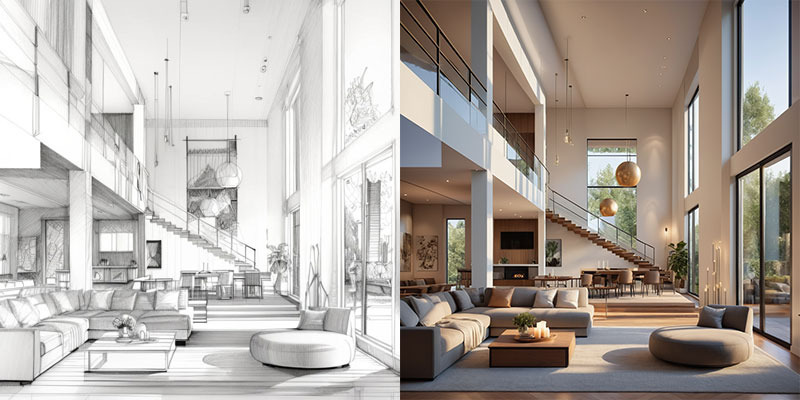دعو الأصدقاء واحصل على عملات مجانية لكم جميعًا

this is a rendering of what a building would look like
Jordi_x
مولد الصور الذكاء الاصطناعي
v2
Create a refined and professional architectural presentation board with a minimalist design and pure, neutral background to ensure the architecture remains the focal point. The board should be divided into three primary sections, each thoughtfully structured to showcase the design in a sophisticated and balanced layout:
Top Section:
Left Side: Present a high-quality photorealistic render of the building’s exterior. The render should highlight the key architectural features, such as innovative materials, textures, and the interplay of light and shadow. Focus on the design’s relationship to its environment, emphasizing how it blends with its surroundings.
Right Side: Allocate space for a succinct and impactful paragraph that describes the design concept. Use a modern sans-serif font for the text, focusing on clarity and simplicity. Briefly outline the design’s inspiration, key features, and its integration with the environment, emphasizing sustainable practices or any specific design goals that define the project.
Middle Section:
Display two architectural floor plans side by side, ensuring they are clear, accurate, and well-scaled. Include detailed measurements, labels, and annotations for critical elements such as windows, walls, and spatial arrangements. Enhance the technical precision of the plans with subtle design elements (such as light accents or shading) to guide the viewer’s focus on key areas without overcomplicating the visuals.
Bottom Section:
Divide this section into three equal columns, each showcasing a photorealistic render of a different interior space within the building. Each render should highlight the functionality, materials, and lighting of the space, illustrating the design’s atmosphere and purpose. The interiors should reflect how the design connects to the user experience and how natural elements like light and ventilation play a role.
Below each render, include a brief description of the space. This text should highlight the function of the room, the materials used, and any design features that enhance the space’s functionality, comfort, and overall aesthetic. Keep the descriptions minimal but informative, aligning with the minimalist approach.
The overall layout should be clean and cohesive, ensuring a smooth flow of information from top to bottom. Use modern typography to clearly distinguish titles, body text, and annotations. The board should project professionalism, with a visually balanced and minimalist design that allows the architectural elements to speak for themselves while maintaining an elegant and sophisticated presentation.
الأسلوب:
تصوير-واقعية معمارية
مشهد:
المستقبلية العضوية
النسبة:
2:3
1
ريمكس
3
أعجبنيلا توجد بيانات حتى الآن
محتوى مشابه أكثر
this is a rendering of what a building would look like
Jordi_x
مولد الصور الذكاء الاصطناعي
v2
Create a refined and professional architectural presentation board with a minimalist design and pure, neutral background to ensure the architecture remains the focal point. The board should be divided into three primary sections, each thoughtfully structured to showcase the design in a sophisticated and balanced layout:
Top Section:
Left Side: Present a high-quality photorealistic render of the building’s exterior. The render should highlight the key architectural features, such as innovative materials, textures, and the interplay of light and shadow. Focus on the design’s relationship to its environment, emphasizing how it blends with its surroundings.
Right Side: Allocate space for a succinct and impactful paragraph that describes the design concept. Use a modern sans-serif font for the text, focusing on clarity and simplicity. Briefly outline the design’s inspiration, key features, and its integration with the environment, emphasizing sustainable practices or any specific design goals that define the project.
Middle Section:
Display two architectural floor plans side by side, ensuring they are clear, accurate, and well-scaled. Include detailed measurements, labels, and annotations for critical elements such as windows, walls, and spatial arrangements. Enhance the technical precision of the plans with subtle design elements (such as light accents or shading) to guide the viewer’s focus on key areas without overcomplicating the visuals.
Bottom Section:
Divide this section into three equal columns, each showcasing a photorealistic render of a different interior space within the building. Each render should highlight the functionality, materials, and lighting of the space, illustrating the design’s atmosphere and purpose. The interiors should reflect how the design connects to the user experience and how natural elements like light and ventilation play a role.
Below each render, include a brief description of the space. This text should highlight the function of the room, the materials used, and any design features that enhance the space’s functionality, comfort, and overall aesthetic. Keep the descriptions minimal but informative, aligning with the minimalist approach.
The overall layout should be clean and cohesive, ensuring a smooth flow of information from top to bottom. Use modern typography to clearly distinguish titles, body text, and annotations. The board should project professionalism, with a visually balanced and minimalist design that allows the architectural elements to speak for themselves while maintaining an elegant and sophisticated presentation.
الأسلوب:
تصوير-واقعية معمارية
مشهد:
المستقبلية العضوية
النسبة:
2:3
1
ريمكس
3
أعجبنيلا توجد بيانات حتى الآن


























